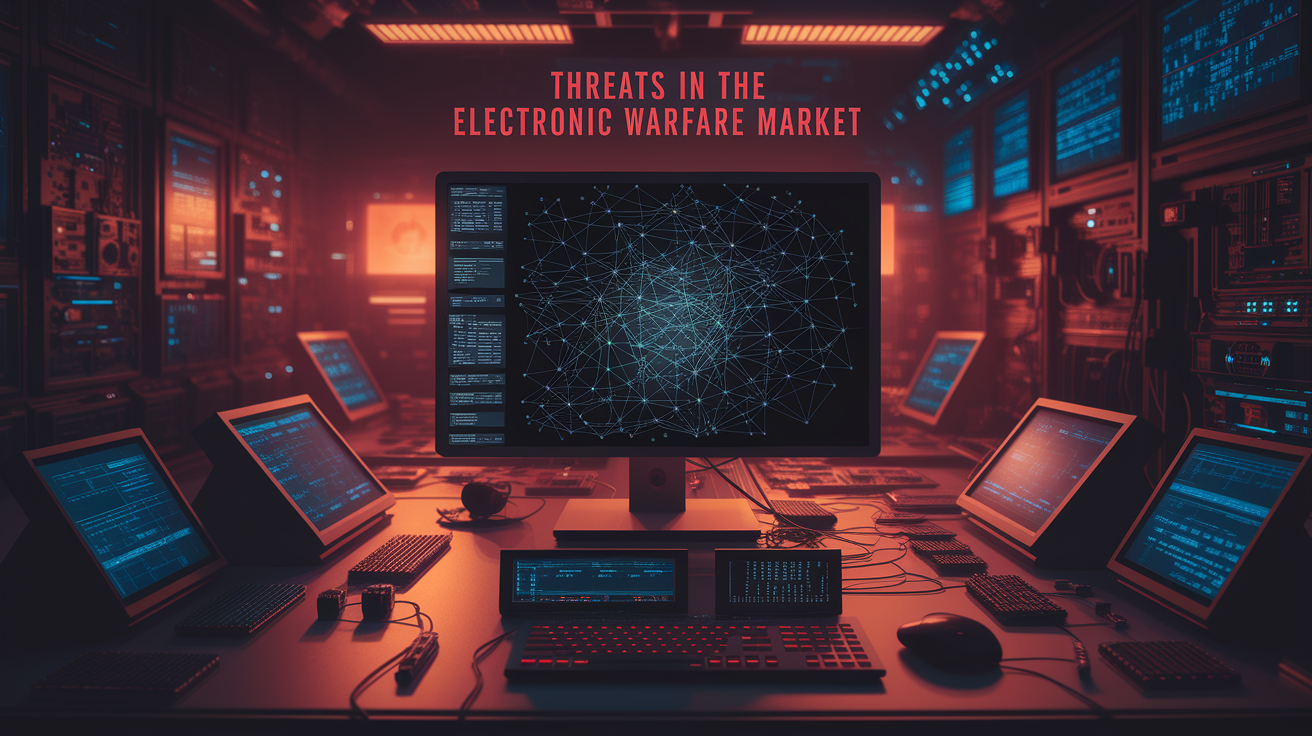
Trends Shaping the Electronic Warfare Market in North America
The Electronic Warfare Market in North America is expanding rapidly as military forces prioritize advanced defense systems to counter evolving threats in modern warfare. With the increasing reliance on the electromagnetic spectrum for communications, intelligence gathering, and cyber operations, electronic warfare has become a critical component of military strategy. The integration of artificial intelligence, machine learning, and quantum computing is transforming electronic warfare capabilities, enhancing detection, jamming, and cyber defense operations. The U.S. and Canada are at the forefront of electronic warfare innovation, investing heavily in new technologies to maintain a strategic advantage in an era where electronic threats are as significant as kinetic warfare. The role of electronic warfare in modern conflicts is continuously evolving, ensuring dominance in the electromagnetic spectrum through advanced jamming, deception, and countermeasure technologies.
Growth and Expansion of the Electronic Warfare Market in North America
The Electronic Warfare Market in North America has witnessed significant growth due to rising defense budgets, increased geopolitical tensions, and the need for modernized military systems. The U.S. Department of Defense and Canadian Armed Forces have been investing in electronic warfare solutions to counter emerging threats from adversaries using sophisticated cyber attack and electromagnetic attack capabilities. The market has expanded with the development of advanced jamming technologies, directed energy weapons, and electronic countermeasures that protect military assets from enemy interference. The demand for electronic warfare solutions spans across land, air, sea, space, and cyber domains, making it a crucial aspect of modern defense strategies. North America remains the largest market for electronic warfare, driven by government initiatives, technological advancements, and strategic partnerships with leading defense contractors.
Get More Info, Download Pdf Brochure: https://www.marketsandmarkets.com/pdfdownloadNew.asp?id=1301
Key Trends Shaping the North American Electronic Warfare Market
The Electronic Warfare Market in North America is shaped by several key trends, including the integration of artificial intelligence in electronic warfare systems. AI-powered solutions are enhancing threat detection, response times, and automation in electronic warfare operations. Another trend is the development of next-generation jamming and spoofing technologies that can disrupt enemy communications and radar systems. The convergence of electronic warfare with cyber operations is also a major factor, as military forces integrate electronic attack capabilities with cybersecurity measures to protect critical networks. Space-based electronic warfare is another growing trend, with the deployment of satellite defense systems designed to counter threats in space. The rise of network-centric warfare, where multiple electronic warfare platforms communicate seamlessly to optimize defense strategies, is further driving market expansion.

Regulatory Landscape and Defense Policies for Electronic Warfare in North America
The Electronic Warfare Market in North America is heavily influenced by defense policies and regulations set by the U.S. Department of Defense and Canadian government. The U.S. military has established the Electromagnetic Spectrum Superiority Strategy to ensure dominance in electronic warfare operations. Regulations governing the use of electronic warfare technologies focus on ensuring compliance with international laws while maintaining national security. The role of the North American Aerospace Defense Command (NORAD) in electronic warfare operations highlights the importance of joint military cooperation between the U.S. and Canada. Government agencies continue to refine policies regarding electronic warfare to address emerging threats while maintaining ethical considerations in electronic attacks and countermeasures.
Applications of Electronic Warfare in Military Operations
The Electronic Warfare Market in North America plays a critical role in military operations, covering electronic attack, electronic protection, and electronic support. Electronic attack systems are designed to jam enemy radars, disrupt communications, and deceive adversarial defense systems. Electronic protection ensures that friendly forces are shielded from electronic threats, utilizing advanced countermeasures to prevent jamming and cyber intrusions. Electronic support focuses on intelligence gathering, signal detection, and threat identification, enabling military forces to anticipate and counter potential attacks. These capabilities are vital in modern warfare, where control of the electromagnetic spectrum can determine the outcome of conflicts. The increasing use of drones, hypersonic weapons, and stealth aircraft further amplifies the need for sophisticated electronic warfare solutions.
Impact of Emerging Technologies on the North American Electronic Warfare Market
The Electronic Warfare Market in North America is being transformed by emerging technologies such as quantum computing, 5G connectivity, and artificial intelligence. Quantum computing is revolutionizing secure military communications, making it nearly impossible for adversaries to intercept encrypted messages. The deployment of space-based electronic warfare assets enhances military capabilities by extending surveillance, jamming, and signal interception to outer space. The adoption of 5G technology is improving real-time data sharing between electronic warfare platforms, enhancing situational awareness and response times. The integration of AI-driven decision-making in electronic warfare systems is optimizing threat analysis and countermeasure deployment, making electronic warfare operations more effective and autonomous.
The Role of Electronic Warfare in Cybersecurity and Defense
The Electronic Warfare Market in North America is closely linked to cybersecurity, as military forces rely on electronic warfare to protect critical infrastructure from cyber threats. Electronic warfare supports cyber defense by detecting and neutralizing malicious signals that could compromise military networks. AI-powered threat detection systems are being integrated into electronic warfare platforms to identify and counter cyberattacks in real time. As cyber warfare becomes a primary battlefield, electronic warfare capabilities are evolving to include cyber-electromagnetic activities that blend electronic attacks with cyber operations. The defense industry is investing in resilient electronic warfare systems that can withstand cyber intrusions and maintain operational effectiveness even under electronic attacks.
North America’s Investment in Electronic Warfare Capabilities
The Electronic Warfare Market in North America continues to receive significant investments from government agencies and defense contractors. The U.S. military has allocated substantial funding for the development and deployment of electronic warfare systems, with major contracts awarded to companies such as Lockheed Martin, Raytheon Technologies, and Northrop Grumman. Canada is also investing in electronic warfare capabilities, particularly in collaboration with NATO allies. The private sector is actively contributing to the growth of electronic warfare solutions by developing next-generation sensors, electronic countermeasures, and AI-powered analysis tools. These investments ensure that North America remains a global leader in electronic warfare technology.

Challenges and Threats in the Electronic Warfare Market in North America
The Electronic Warfare Market in North America faces several challenges, including countering adversarial electronic warfare threats from global competitors. Countries like China and Russia are developing advanced electronic warfare capabilities, requiring North American military forces to continuously innovate. Spectrum congestion is another challenge, as the increasing use of electronic systems in civilian and military applications leads to interference issues. Ethical and legal concerns surrounding electronic warfare also pose challenges, particularly regarding the use of offensive electronic attacks. Addressing these challenges requires continuous research, policy development, and collaboration between government agencies and private sector innovators.
Electronic Warfare in Joint Military Operations and Coalition Forces
The Electronic Warfare Market in North America plays a vital role in joint military operations and coalition forces. The collaboration between the U.S., Canada, and NATO allies strengthens electronic warfare capabilities through shared intelligence, joint exercises, and coordinated defense strategies. Electronic warfare is a key component of multi-domain operations, where land, air, sea, space, and cyber forces work together to achieve strategic objectives. Training programs for electronic warfare specialists ensure that military personnel are equipped with the skills needed to operate advanced electronic warfare systems effectively.
The Future of the Electronic Warfare Market in North America
The Electronic Warfare Market in North America is poised for continued growth, driven by advancements in AI-powered autonomous electronic warfare systems, improved spectrum management, and increased defense spending. The future of electronic warfare will see greater reliance on autonomous systems, AI-driven decision-making, and integrated cyber-electromagnetic warfare strategies. Forecasts indicate strong market expansion, with defense agencies prioritizing electronic warfare capabilities in response to evolving threats. The ability to control the electromagnetic spectrum will remain a key factor in military superiority, shaping the future of defense strategies across North America.
80% of the Forbes Global 2000 B2B companies rely on MarketsandMarkets to identify growth opportunities in emerging technologies and use cases that will have a positive revenue impact.
- Leading Automated Guided Vehicle Companies 2024: An In-depth Analysis
- CHARGED UP: SHIFT TO E-MOBILITY AND THE EVOLUTION OF TRANSPORTATION
- Global Automotive Market: Predictions For 2024
- Revolutionizing Depot Charging: Hockey Stick Growth on the Cards
- The Future of Silicon Battery Industry: Innovations and Market Outlook


